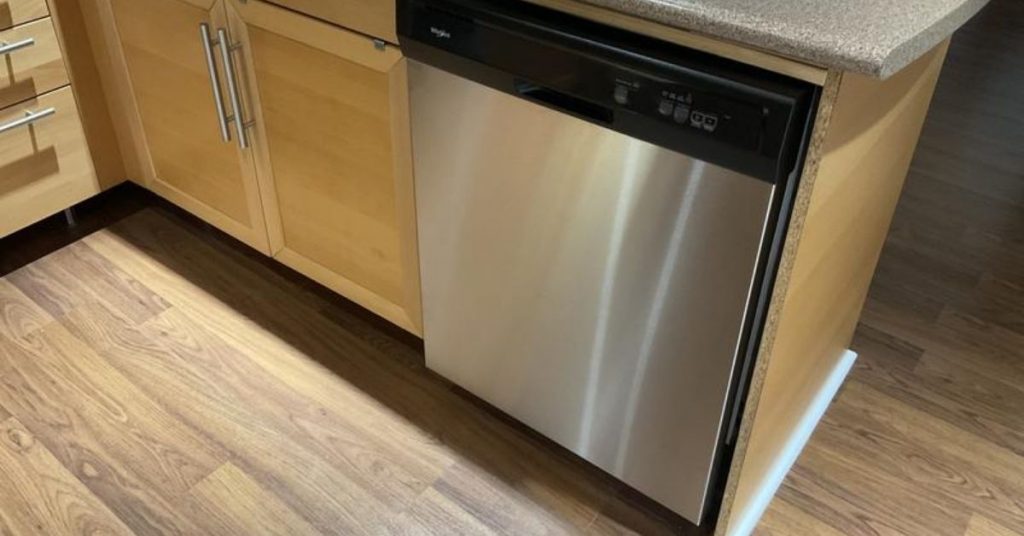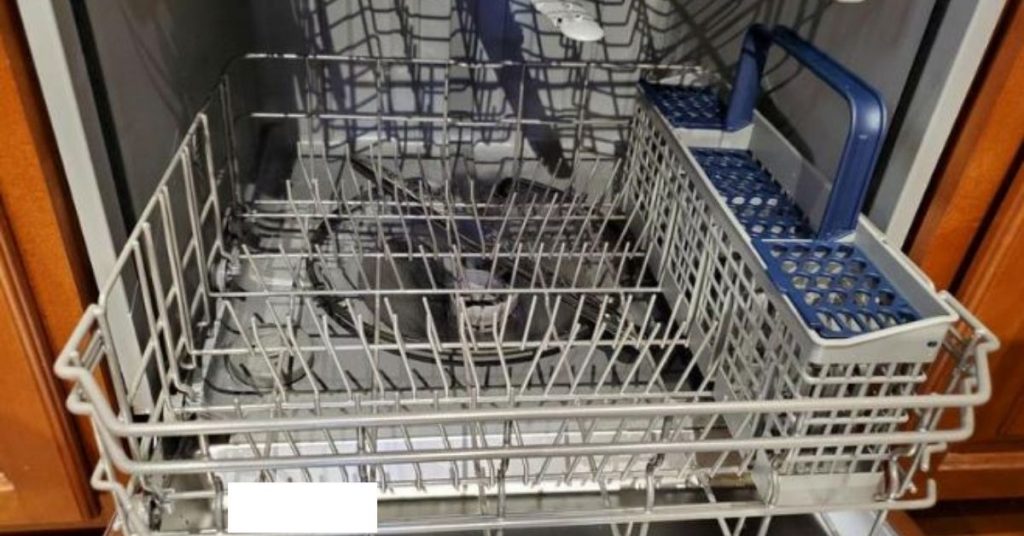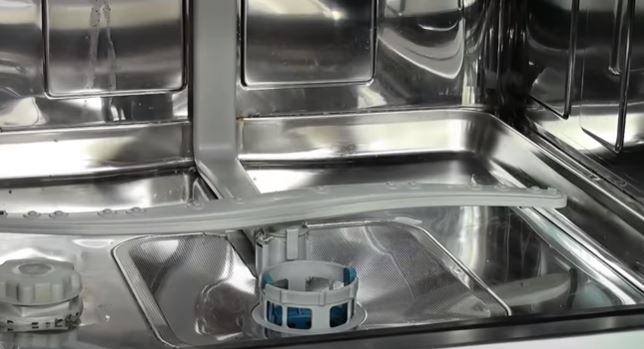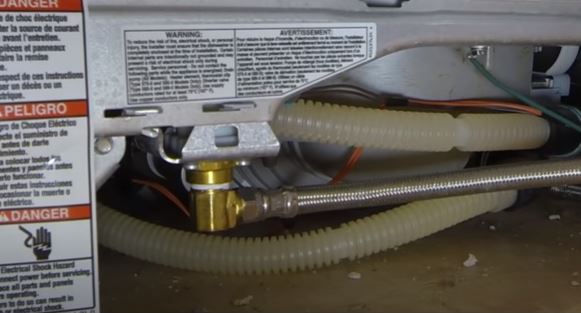
A leaking dishwasher is usually caused by a worn out door gasket, loose or bent door latch, faulty inlet valve, cracked hoses, loose hose connections, damaged/jammed spray arm, defective float switch or using the wrong detergent.
Here is a brief summary of this post:
Causes
- Door Seal Damage: A damaged or deteriorated door seal or gasket can allow water to escape during the dishwasher’s cycle.
- Faulty Door Latch: If the door latch is not securely holding the dishwasher door closed, water can leak out during operation.
- Loose or Damaged Hose Connections: Loose or damaged hoses, such as the drain hose or water inlet hose, can lead to water leakage.
- Clogged Drainage: A clogged drain hose or garbage disposal connection can cause water to back up and leak from the dishwasher.
- Excessive Detergent: Using too much detergent or the wrong type can result in excessive suds and leaks.
- Dishwasher Overfilling: If the dishwasher’s float switch is malfunctioning, it may allow the appliance to overfill with water, causing leaks.
How to Fix It
- Inspect Door Seal: Examine the door seal or gasket for any signs of damage, wear, or buildup. Replace it if necessary.
- Check Door Latch: Ensure that the dishwasher door latch is working correctly and securely holding the door closed during operation.
- Tighten Hose Connections: Inspect all hose connections, including the drain hose and water inlet hose, for tightness. Replace any damaged hoses.
- Clear Drainage: Check for clogs in the dishwasher’s drain hose and the connection to the garbage disposal or drain pipe. Remove any blockages.
- Adjust Detergent Usage: Use the correct type and amount of dishwasher detergent as recommended in the appliance manual. Avoid excessive detergent that can lead to leaks.
- Replace Float Switch: If the dishwasher overfills, the float switch may be defective and need replacement. Consult a professional technician for this repair.
- Regular Maintenance: To prevent future leaks, perform regular maintenance, including cleaning the dishwasher’s filter, checking hose connections, and inspecting for signs of wear or damage.
- Professional Help: If the issue persists or if you’re unsure about the cause, it’s advisable to contact a professional appliance repair technician to diagnose and fix the problem safely.
How to Fix a Leaking Dishwasher
The solution for a leaking dishwasher depends on what is causing it to leak in the first place. The following are the causes of a leaking dishwasher and how to fix them:
1. Worn Out/Damaged Door Seal

A dishwasher door seal/gasket is the rubber ring installed around the inside of the door along a groove. It helps to create a tight seal such that water cannot leak out during a cycle.
After years of usage, the rubber seal may become hard and brittle causing it to crack easily. The constant closing and opening of the door also causes it to wear out and it is no wonder a faulty door seal is the most common cause of leaks in a dishwasher.
If your dishwasher is leaking from the bottom of the door, you most likely have a worn out door gasket. This makes it impossible for the door to make a watertight seal and hence the leak.
Apart from being worm out, the seal can also cause a leak if it is dirty. Food scraps, scum and other types of debris can embed along the edge of the seal preventing it from sealing properly.
The solution in this case depends on what is causing the leak. If the seal looks genuinely dirty, pry it off and clean it. Use warm soapy water and a soft cloth or sponge to clean the groove and remove all the embedded gunk. wipe down the seal as well.
Put the seal back and start a short cycle. If the leak stops then you are sorted. On the other hand if there is still a leak you will need to replace the seal.
Refer to your user manual or look for your dishwasher model number on the inside of the door. Use the model number to order a replacement seal.
While installing the new seal, soak it in warm soapy water for lubrication and hence ease of installation. A few plumbers I know use Vaseline instead.
2. Loose or Bent Door Latch
A door latch is what keeps the door tightly closed during a cycle. When the door latch is too loose or bent, water will seep out under the door and pool underneath the dishwasher.
If your dishwasher door closes or opens easily, that is a sign that the door latch is loose or not latching properly.
For a loose door latch, use a screwdriver to tighten it. Start a cycle and check if that solves the problem.
A faulty door latch will need to be replaced. Again, this is a simple task.
3. Faulty/Jammed Spray Arm

A dishwasher spray arm has holes along it where water shoots from and cleans/rinses the dishes. It is also designed to spin so that the water can reach all around the dishes.
Several things can happen and interfere with the working of a spray arm. To start with, a broken/cracked spray arm will force water under the door resulting in leaks.
Dishes, especially spoons and folks can jam the spray arm, preventing it from spinning and event dislodge it from its position. When that happens, water will leak from the bottom of the dishwasher as well.
To check if this is the problem, open the dishwasher and remove the lower dish rack. As you slowly slide out the rack, check if there are any dishes from the rack jamming the spray arm.
Try to spin the pray arm with your hander to check if it spins freely. To remove the spray arm, grab it and turn it ¼ turn counterclockwise and lift it off.
Inspect it for cracks or even blocked holes. If it looks damaged order a replacement and install it as easily as you removed the old one.
4. Faulty Float Switch

A dishwasher float assembly works like your toilet float or the one in your sump pump. It regulates the water level inside the dishwasher tub.
At the beginning of the cycle, the float is at the bottom of the tub. As the water level rises, the float rises with it until its set level when it triggers the float switch to turn off the water inlet valve.
If the float switch is faulty, it will fail to turn off the inlet valve and as a result the water level will rise higher and ultimately leak out.
To really know if the float switch is the problem, open the dishwasher mid-cycle and check the water level inside the tub. Ideally, the level of water should be below the heating element. If it is higher than that you will need to replace the float switch.
Alternatively, you can use a multimeter to test for continuity across the float switch. Replacing a dishwasher float switch is not that hard but I would ask you to check you dishwasher user manual or search for one in the company website.
5. Defective Water Inlet Valve

Water is supplied to the dishwasher through an inlet valve usually at the left bottom corner of the dishwasher in most dishwasher models. To access it, you will need to remove the dishwasher kick toe.
The dishwasher inlet valve’s opening and closing is regulated by the float switch. Sometimes the inlet valve will fail to respond to a command sent by the float switch and remain stuck in the open position, thereby continuously filling the dishwasher.
To check if indeed that is the problem, open the dishwasher door mid-cycle and check the level of water in the tub. If the level of water in the tub is already too high but still the inlet valve is delivering more water, it is the culprit and will need to be replaced.
A dishwasher water inlet valve cannot be repaired. You must replace it with a new one once it has failed.
- To replace the water inlet valve, start by turning off water to the dishwasher. The shut off valve is located under the kitchen sink, connected to the sink’s hot water supply line.
- Place towels under the water supply house connecting to the valve.
- Disconnect the water supply hose to the inlet valve using a pair of pliers.
- You will also see 2 wires connected to the valve. These are the ones that send opening and closing commands. Carefully remove them and label them as such so that it is easier for you when connecting them to the new valve.
- Remove the faulty valve.
- Install the new valve and connect the wires and water supply hose.
- Turn on the water and install the kick toe.
6. Worn out Motor Shaft Seal
If your dishwasher is specifically leaking from underneath it, you could be dealing with a worn out motor seal. This is a $5 dollar replacement part but if you don’t know how to replace it then you will end up paying a plumber good money for 5 minutes of work.
The video below will show you how to easily replace a dishwasher motor shaft seal.
7. Damaged Drain Hose
A drain hose is used to carry wastewater from the dishwasher to the garbage disposal or sink drain line. This hose can crack or become loose especially where it is connected to the drain pump.
To check if a damaged drain hose is the cause of a leaking dishwasher, remove the toe kick and keenly observe for leaks when the dishwasher is draining.
- Place a pan or small container under the drain hose and pump connection to prevent spilling any water on the floor.
- Pinch the clamp using a pair of pliers and try to force it in if it is loose.
- Check if that fixes the problem
If the drain hose is evidently cracked, you will need to replace it.
- Again, pinch the clamp on the drain pump connection and pull the hose out. Let the water drain out into the pan.
- Do the same on the other side where the hose is connected to the garbage disposal or sink drain line.
- Connect the new drain hose.
- Connect the toe kick.
8. Dishwasher is not Draining
If the dishwasher is not draining, wastewater will accumulate inside the tub and leak out. Usually, this problem is caused by a clogged filter, jammed pump impellers or even a clogged drain hose.
I have written a detailed guide on how to fix a dishwasher that is not draining. Read it here.
9. Dishwasher is not Level
Is a new dishwasher leaking? It is unthinkable that a new dishwasher would have worn out parts. The likely scenario in that case would be a dishwasher that is not properly aligned.
For a dishwasher to work effectively, it needs to be sitting level on the floor. Place a carpenter’s level on the dishwasher’s lower rack rail and check if it level or slanting.
If the dishwasher is not level, adjust the leveling screws on the front legs and keep checking with the carpenter’s level until the dishwasher is level.
10. Wrong Dishwasher Detergent
Using the normal dish soap in a dishwasher will result in excessive foaming forcing soapy water to leak from the dishwasher. To prevent this, just restrict yourself to dishwasher detergent and you will have fixed the problem.
And basically that is how to fix a leaking dishwasher. I hope this guide was helpful.
Related: Leaking dishwasher air gap





